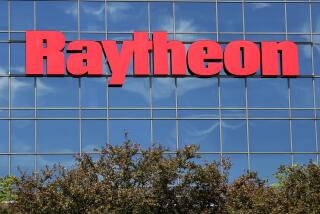TRW Contract on Spy Satellite Voided by GAO : Aerospace: Lockheed, Martin Marietta had accused firm of low-balling bid. Now they all must submit new ones.
- Share via
WASHINGTON — TRW won a top-secret, multibillion-dollar contract to build a new spy satellite fleet earlier this year, but the General Accounting Office has ruled that the contract must be put up for bid again because Lockheed and Martin Marietta protested the award.
If TRW is unsuccessful in winning the contract a second time, it would forgo revenues estimated at more than $5 billion and halt the creation of more than 1,000 jobs in Southern California.
Exactly why the GAO, which has the authority to hear such protests, recently ordered the rebidding remains unclear, but the protesting firms had claimed that TRW submitted an unrealistically low bid, industry sources said Friday.
The award is being hotly contested largely because the military space industry is facing a painful dearth of new orders, and the losers may eventually be forced out of the military spacecraft business.
Spokesmen for TRW, Lockheed, Martin and the Pentagon declined to comment.
The decision to reverse the large award is highly unusual. Defense industry experts could not recall a similar case in recent years, despite the fact that numerous protests have been filed.
The contract was awarded by the National Reconnaissance Office, an independent federal agency that acts as the procurement arm for spy satellites used by the military services and the Central Intelligence Agency.
The satellite, known either by the designation 7795 or P-81, would use an advanced radar system to search the skies for enemy combat jets as well as other targets on the ground. It would succeed an earlier generation of satellites produced by TRW and Martin.
The value of the program, as well as its very existence, is classified, but defense industry experts estimate the design and production would cost roughly $5 billion to $10 billion over eight to 10 years.
Depending on how quickly that money was spent, the program might employ roughly 1,000 to 2,000 people. TRW would build the satellite in Redondo Beach. Lockheed would conduct its work in Sunnyvale, Calif., and Martin in Denver.
For TRW, the program is crucial to its future as a military satellite producer, said John Pike, a space expert at the Federation of American Scientists. Pike speculated that both Martin Marietta and Hughes Aircraft have assured futures in the industry, but Lockheed and TRW are fighting hard for a place amid rapid consolidation.
Last year, TRW, Lockheed and Aerojet became embroiled in another nasty battle over a spy satellite system, known as the Follow-on Early Warning Satellite, which was eventually canceled.
The reversal puts TRW in an exceptionally awkward position, defense industry officials said. If TRW did low-ball the bid, it is not clear whether it can justify an even lower bid now. Meanwhile, Lockheed and Martin now know the price TRW offered to win the contract.
The new satellite will use a so-called phased array radar, which has a radar beam that is steered electronically rather than with a moving dish antenna. Such radars can identify and track targets more quickly and accurately.
More to Read
Inside the business of entertainment
The Wide Shot brings you news, analysis and insights on everything from streaming wars to production — and what it all means for the future.
You may occasionally receive promotional content from the Los Angeles Times.









